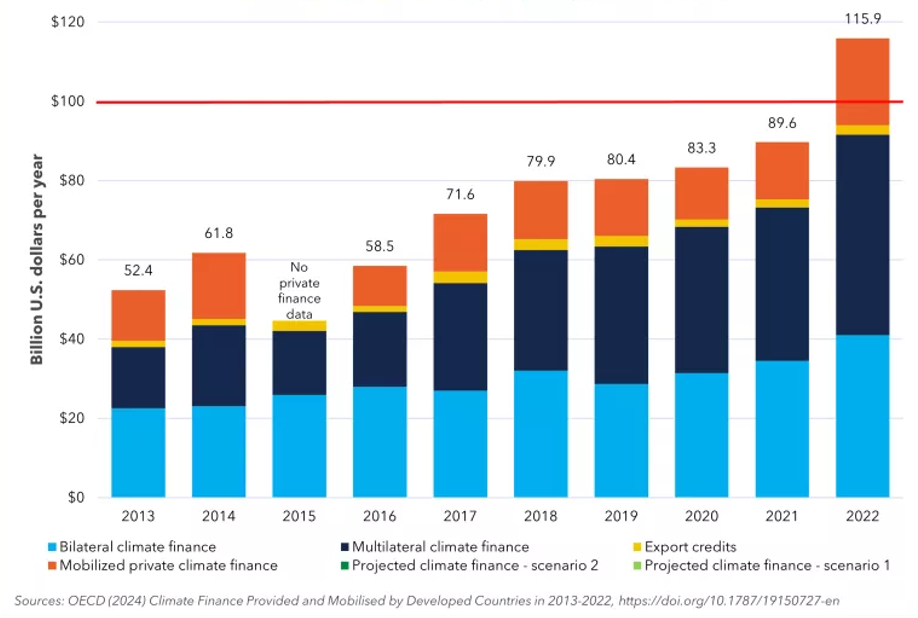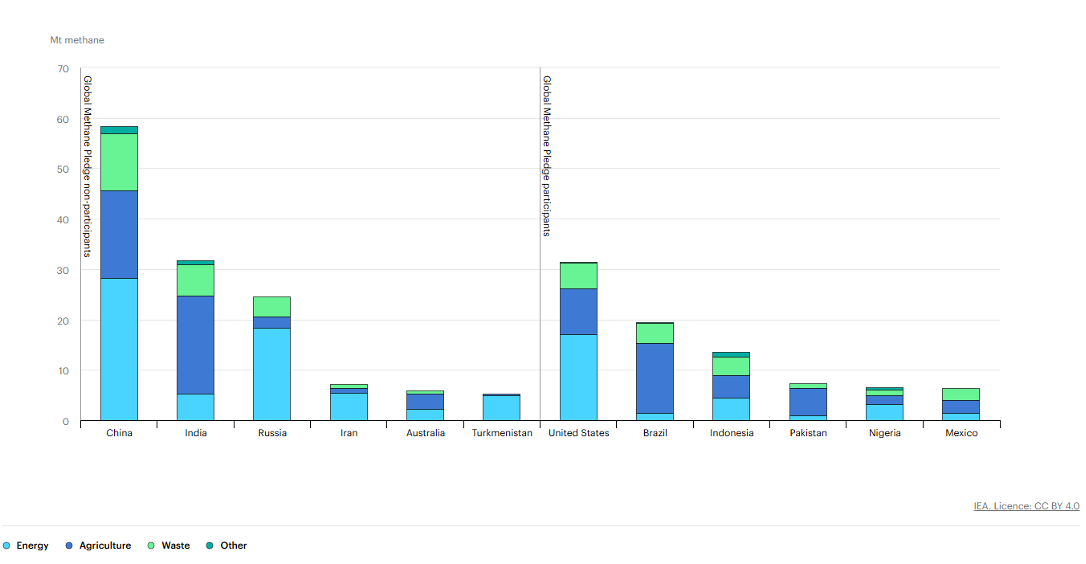Over 50,000 participants from nearly 200 member countries gathered in Baku, Azerbaijan for the United National climate conference, COP29. The gathering, dubbed the Finance COP, prioritized setting the new climate finance goal to support the clean energy transition in developing economies. An agreement was also reached on carbon credit rules, allowing countries to trade carbon credits with each other and with companies. Additional focus areas included committing to reduce methane emissions, establishing adaptation funds, and expanding nuclear energy capacity.
Here are the key highlights from COP29:
Climate Finance
Tripling the budget from the previous climate finance goal, developed countries recognized the significance of climate investment needs of developing countries and offered $300 billion a year by 2035 in public funding to help developing nations transition to a low-carbon economy and adapt to extreme weather impacts. The top areas of investment include mitigation and adaptation efforts including the launch of the Loss and Damage Fund. Beyond public commitments, discussions landed on a new financial goal of securing $1.3 trillion annually from both public and private sources.
At Cop15 in 2009, developed countries committed to a collective goal of mobilizing $100 billion annually by 2020 and was achieved for the first time in 2022 with $115.9 billion provided and mobilized. As the timeline for the previous $100 billion annual goal comes to a close, all eyes were on COP29 to negotiate a “New Collective Quantified Goal” (NCQG) on climate finance for 2025 to 2035.

Annual Reported Climate Finance from Developed to Developing Countries Towards the $100 Billion Per Year Goal (2013 – 2022)
Source: NRDC - Getting from Here to There: Scaling Up Climate Finance for the NCQG
Many attending nations called for a vast increase in the climate finance goal. Government requests to the United Nations Framework Convention on Climate Change (UNFCCC) including the African Group of Negotiators, Arab Group, and Like-Minded Developing Countries Group.
From the private sector, the world’s largest multilateral development banks (MDBs) announced a new goal to raise $120 billion in annual climate finance for developing nations by 2030. This goal is 1.6 times greater than the group’s target of $75 billion last year. Some of the MDBs who signed the agreement include: the Asian Development Bank, the African Development Bank Group, and the MDB Group (which includes the World Bank, European Investment Bank, and the Inter-American Development Bank).
Other key climate finance news include:
- Asian Development Bank (ADB) plans to invest up to an additional $7.2 billion in climate-related lending after U.S. and Japan agreed to underwrite some of its existing sovereign loans. Additionally, ADB announced a 7-year $3.5 billion climate adaptation program in the Central Asia, Pakistan, and Southern Caucasus by promoting food security and sustainable water use.
- Association of Banks of Azerbaijan committed $1.2 billion to finance projects that aid the country's transition to a low-carbon economy.
- Sweden contributed $730 million to the UN Green Climate Fund (GCF) to invest in climate initiatives that support low-and middle-income countries advance in adaptation measures in response to climate change and reduce emissions.
- Acumen, a nonprofit impact investor, invested $300 million over the next 5 years to support agricultural adaptation projects in Latin America, India, East and West Africa, and Pakistan.
Carbon Credits Agreement
Taking roughly a decade to reach an agreement, the progress made at COP29 was crucial in creating functional carbon markets to meet the Paris Agreement and mobilize capital. Under Article 6.4, Paris Agreement Crediting Mechanism (PACM), negotiators from almost 200 governments endorsed a framework to create new structure for the United Nations-led global carbon market. Responsible for overseeing the mechanism, the supervisory body has a comprehensive action plan for next year. The new standards aim to support climate action by increasing demand for carbon credits, potentially reducing the cost of implementing national climate plans by $250 billion annually.
Article 6.2 was also approved by climate negotiators to allow different players, like private sector companies and countries to exchange emissions removals and reductions through bilateral agreements. While some industry groups voiced concern over the climate integrity of carbon credits, the carbon credit agreement critically details an accounting system that ensures credits from being used twice. The decision was a culmination of over 10 years of work and supports strong standards for a centralized carbon market that would help countries reduce emissions and implement their climate plans in an efficient and cheaper way.
Focus on Methane Emissions
More than 30 countries, accounting for over 50 percent of global methane emissions from organic waste, committed to addressing methane emissions through the Declaration of Reducing Methane from Organic Waste. This group includes the Brazil, Japan, Mexico, Nigeria, Russia, UK, and US, which are all among the world’s 10 largest methane emitters. Supporting previous COP commitments, this declaration pledges countries to reduce their global methane emissions by at least 30 percent by 2030, using a 2020 baseline.

Source: International Energy Agency - The Global Methane Pledge
Adaption
Towards the end of COP29, the Loss and Damage Fund was launched to provide financial assistance to the most vulnerable countries to the impacts of climate change including least developed countries, African nations, and small island states. This fund pledges over $730 million and is scheduled to start financing projects as soon as next year.
During COP29, the White House announced that the U.S. financed more than more than $3 billion to the President’s Emergency Plan for Adaptation and Resilience (PREPARE) to assist vulnerable countries in adapting to climate change.
Co-led by the U.S. Department of State and U.S. Agency for International Development (USAID), PREPARE strives to help more than 500 million people in developing countries adapt to and manage the impacts of climate change by 2030. The Biden Administration met its adaptation finance pledge for the first time in fiscal year 2023.
Under PREPARE, the USAID shared that for every $1 invested in extreme weather preparedness can yield $2 to $10 in savings by avoiding future humanitarian aid costs. An example of these investments targeting measures to alleviate weather damage is the Early Warning for All Initiative. This PREPARE initiative allocates $83 million to provide flood and flash flood early warning systems. This initiative aims to support over 3 billion people in 100 countries by 2027. As part of its Climate Smart and Disaster Ready program, USAID provided an additional $11.8 million to strengthen climate adaptation for vulnerable communities, bringing the total investment to $16.2 million.
Nuclear Energy
Nuclear energy was also a highlight of COP29 as an option for delivering reliable, low-carbon power with relatively high price stability, addressing growing energy demands and the escalating climate crisis. El Salvador, Kazakhstan, Kenya, Kosovo, Nigeria and Turkey joined the pledge from last year to triple global nuclear capacity by 2050.
The US and UK also signed a new agreement for civil nuclear collaboration, which aims to pool billions in research funds to expedite the development of new technologies to boost energy security and help decarbonize the heavy industrial industry. The UK will lead the forum, ensure availability for industrial use by 2030, and facilitate information-sharing on advanced nuclear technologies.
Recap of Additional Key Announcements
Deforestation Pledge: The UK made a pledge of £239 million to tackle deforestation in countries such as Indonesia and Colombia. The fund will be broken down to dedicate £188m to support “the development of high-integrity forest carbon markets”; £48m for blended finance to unlock private investment in sustainable forest businesses; and £3m for the UNFCCC to support countries protecting their forests.Coalition on Phasing Out Fossil Fuel Incentives Including Subsidies (COFFIS): Colombia, New Zealand, and UK joined the COFFIS, a Dutch-led coalition of governments working together to facilitate transparency toward the phase-out of fossil fuel subsidies and remove barriers. With the coalition growing to a total of 16 countries, each coalition country commits to publishing their fossil fuel subsidies inventory annually after joining and developing national action plans to phase out fossil fuel subsidies.
Additional Resources:
Many other pledges, announcements, and proposals were shared during COP29. Some resources to learn more:
· What Is 'Loss and Damage' From Climate Change? 8 Key Questions, Answered
· The Energy Gang: Live From COP29 – Everyone Is Talking About Climate Finance. What Do They Mean?
· Bloomberg Zero: COP29’s Big Messy $300 Billion Climate Deal
· Institute of International and European Affairs (IIEA): Reflections On COP 29 Podcast
Looking ahead to COP30 at Brazil the agenda is projected to focus on carbon markets and the new quantified goal on climate finance, as well as establish individual country commitments for cutting greenhouse gas emissions by 2035.
This material is for informational purposes only.